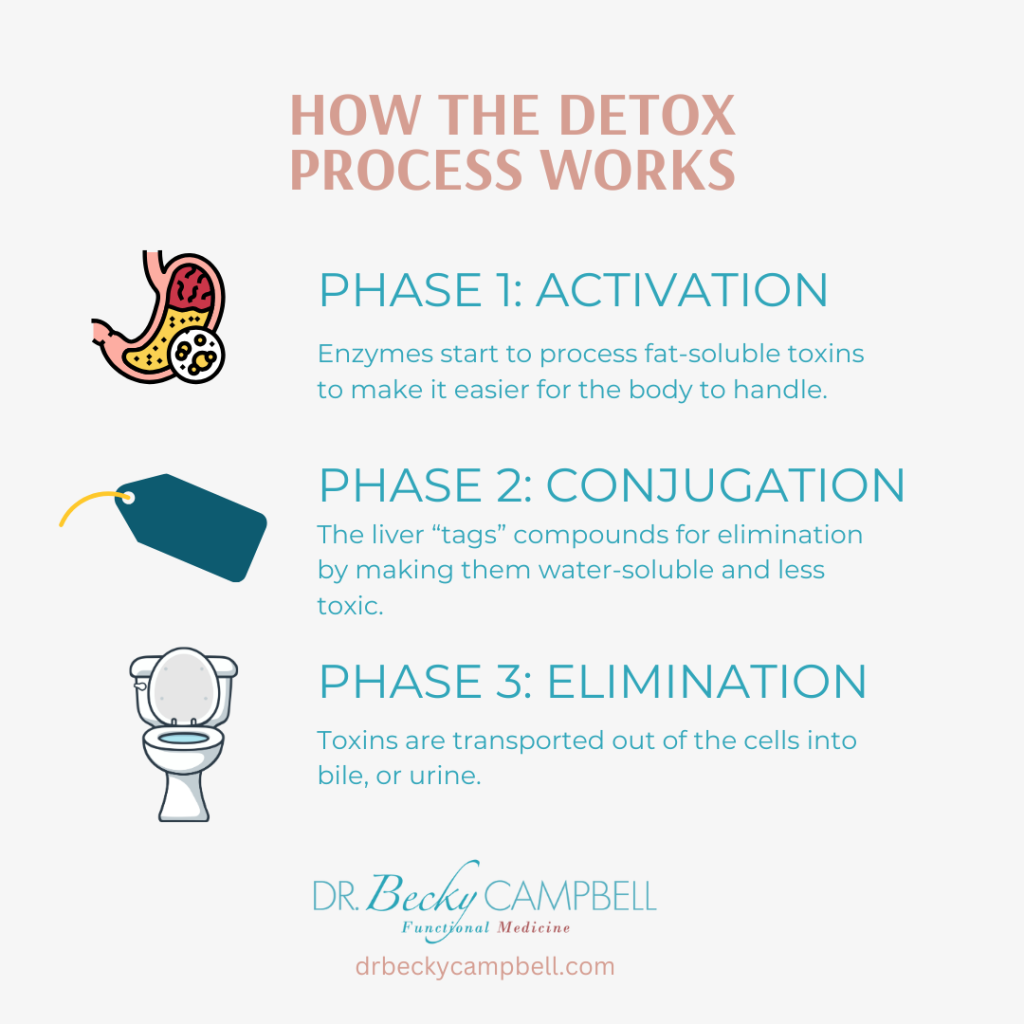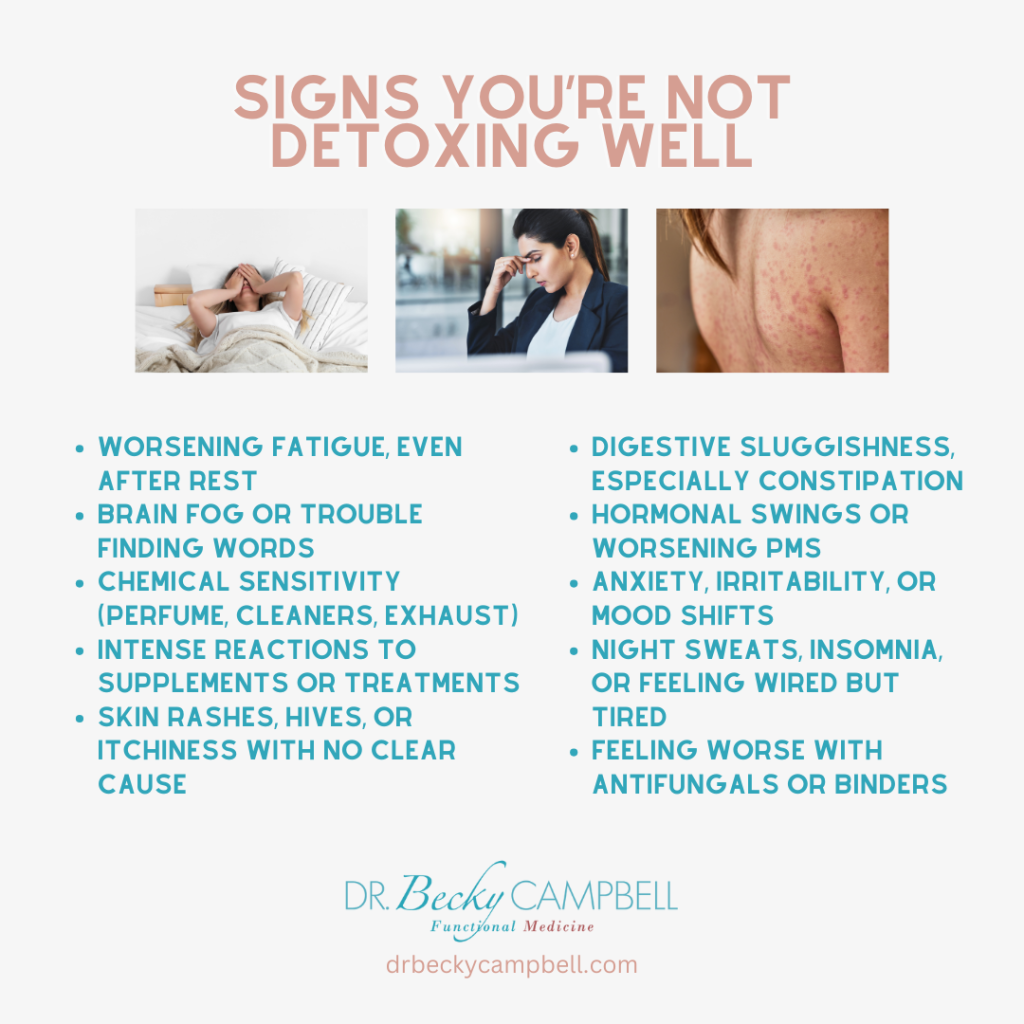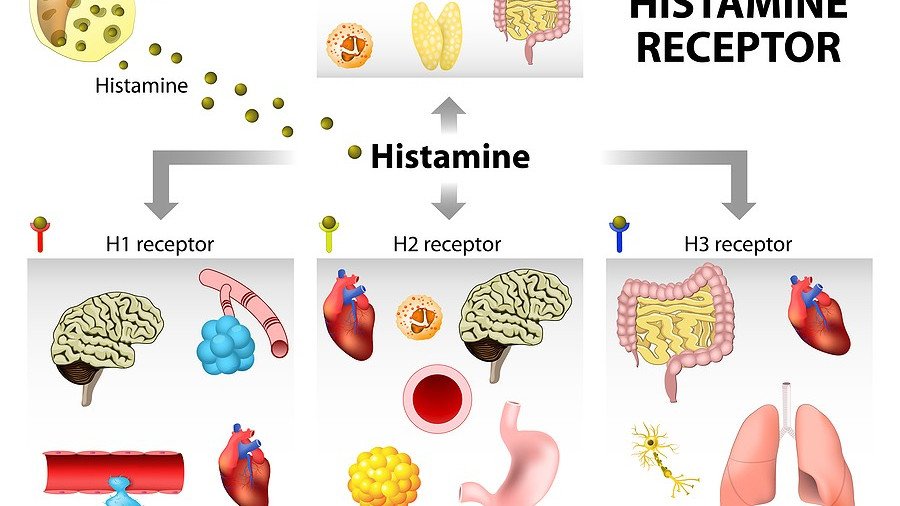Understanding mycotoxins metabolism, detox blocks, and how to move forward.
You’re doing all the right things, but still feel wrecked by mold.
You’ve swapped out your environment, cleaned up your diet, added binders, maybe even started sauna sessions or lymph work. And instead of feeling better… you feel worse.
If you’ve ever said, “Why can’t my body just get rid of this stuff?” – you’re not alone. And no, your body isn’t broken. But it is likely overwhelmed.
When it comes to mold illness, the problem isn’t just exposure; it’s what your body has to do with the toxins mold leaves behind.
Mycotoxins don’t clear themselves. They have to be processed, neutralized, and eliminated through your body’s detox pathways. And for many people, that system just isn’t working the way it should.
In this blog, we’ll unpack exactly how the body metabolizes mycotoxins, why some people struggle more than others, and what it means when detox stalls or backfires.
Whether you’re just getting started or you’ve been stuck for months, this post will help you understand what’s happening inside and give you a clearer path forward.
What Mycotoxins Actually Do In Your Body
Let’s clear this up: mycotoxins aren’t just “mold stuff.” They’re biochemical weapons – tiny, potent compounds mold releases to compete, dominate, and survive. (1) And when they get into your body, they don’t just sit there. They cause serious disruption.
Because mycotoxins are fat-soluble, they slip into cells and tissues with ease. They’re slow to clear, especially when your detox pathways are already under strain.
On top of that, they tend to fly under the radar, not always triggering an obvious immune response right away. That’s why so many people live with chronic symptoms for months or years before connecting the dots.
Inside the body, these toxins spark inflammation, confuse the immune system, and interfere with mitochondria – the energy engines of your cells. They can block enzymes, disrupt cell signaling, and even damage DNA.
Worse, they impair the very systems your body relies on to get rid of them, making detoxification harder the longer they stick around.
This is why getting out of a moldy environment isn’t the end of the story. You have to process and eliminate the toxins themselves.
Until your body can do that efficiently, it will keep responding like the threat is still there, and you’ll keep feeling stuck in survival mode.
The Detox Process And Where It Breaks Down
Detoxification isn’t a one-and-done process. It happens in phases, and each relies on the others working smoothly. If any step slows down or stalls, toxins get backed up, circulating longer, causing more damage, and making you feel worse instead of better.
Here’s how the detox process works:
-
Phase 1: Activation
This happens mainly in the liver, where enzymes start to process fat-soluble toxins like mycotoxins. (2) These enzymes chemically modify the toxins to make them easier for the body to handle. In the process, the toxins are turned into intermediate compounds that are often more biologically active. If Phase 2 can’t keep up, these intermediates can hang around too long and irritate cells or tissues, contributing to inflammation or oxidative stress.
-
Phase 2: Conjugation
Your liver attaches molecules like glutathione, sulfate, or glycine to those reactive intermediates. This “tags” them for elimination by making them water-soluble and less toxic. Conjugation depends heavily on nutrient availability, especially antioxidants, amino acids, and sulfur compounds. (3, 4)
-
Phase 3: Elimination
Finally, the now water-soluble toxins are transported out of the cells into bile or urine via transporter proteins. From there, they move into stool or urine and out of your body. This stage relies on proper bile flow, kidney function, regular bowel movements, and lymphatic drainage. (5)
Think of it like a busy factory with three departments: the first breaks down raw materials, the second packages them up safely, and the third ships them out. If shipping is delayed (say, you’re constipated or your bile flow is sluggish), the whole system backs up. That backlog creates pressure everywhere else in the chain.
This is where a lot of people get stuck.
They jump straight into binders or detox protocols without first supporting the body’s drainage. But you can’t detox faster than you can drain. Otherwise, you’re just stirring up toxins and moving them around, without actually getting rid of them.
If you’ve ever felt worse after starting detox supplements, this may be why. Your body is trying to clear the backlog, but those stirred-up toxins have nowhere to go if the exit doors aren’t open.

Why Some People Can’t Detox Mold Effectively
You’ve seen how mycotoxins hijack key systems in the body. And you’ve seen how detoxification is a multi-phase process that depends on coordination, resources, and capacity. So it’s no surprise that symptoms can pile up fast when something interrupts that process.
But here’s what you need to know: if your body isn’t clearing mold well, it’s not because you’re too sensitive or fragile. It’s because the burden has outpaced your body’s ability to keep up.
And that is a capacity issue, not a character flaw.
Some of this comes down to your genes. Variants in detox-related genes like MTHFR, GST, or certain CYP450 enzymes can affect how quickly or efficiently your body processes and eliminates toxins. (6, 7)
These variations aren’t rare, and they aren’t inherently bad. But in the context of mold exposure, they can make a big difference.
Genetics is just one piece of the puzzle, though. Your overall toxin burden, nutritional reserves, gut health, mitochondrial function, and even hidden infections all influence your detox capacity. (8)
If you’re missing key nutrients, your gut is sluggish, or dealing with other stressors like viruses, parasites, or hormone imbalance, your detox pathways can get overwhelmed.
Think of it like a sink. The water rises if the faucet is gushing and the drain is clogged. The problem isn’t that your sink is defective – it’s just under too much pressure.
That’s why mold recovery looks different for everyone. Your body isn’t failing you. It’s doing everything it can with the resources it has.
Clues You’re Not Detoxing Mold Well
If your detox pathways are under strain, your body will usually let you know – it just might not speak in obvious ways.
Many mold-exposed patients miss the signals because they don’t realize how wide-reaching detox stress can be.
Here are some of the most common red flags:
- Worsening fatigue, even after rest
- Brain fog or trouble finding words
- Chemical sensitivity (perfume, cleaners, exhaust)
- Intense reactions to supplements or treatments
- Skin rashes, hives, or itchiness with no clear cause
- Digestive sluggishness, especially constipation
- Hormonal swings or worsening PMS
- Anxiety, irritability, or mood shifts
- Night sweats, insomnia, or feeling wired but tired
- Feeling worse with antifungals or binders

These aren’t proof that your body is broken. They’re signals that your detox system needs more support.
When you learn to listen, without fear or frustration, you can respond with what your body needs.
Next, we’ll talk about how to do just that.
How to Support Detox (Without Making It Worse)
So, what can you do when the signs of detox stress start showing up?
Start by slowing down.
Supporting detox isn’t about forcing your body to purge – it’s about partnering with it.
That means matching the pace of your support to your body’s capacity, not your symptoms. And it means building a solid foundation before pushing anything out.
Here’s how I walk patients through that process:
Start with Drainage: Open the Exits
You can’t detox faster than you can drain.
Constipation, sluggish bile, and poor lymph flow are all signs that your body’s trying to eliminate but getting stuck.
This is where we start.
Think castor oil packs over the liver, vagus nerve toning, and nervous system regulation. It’s not flashy, but it’s powerful.
Then, Create Gentle Flow
Once the exits are open, you can support the systems that carry toxins out.
Lymphatic tools like dry brushing or rebounding, epsom salt baths to sweat and soothe, and basic liver nutrients help keep things moving without overwhelming the system.
Finally, Mobilize – If Your Body Is Ready
Infrared sauna, binders, or deeper protocols can be helpful, but they come last.
When people dive in here first, they often feel worse. But when you’ve laid the groundwork, these strategies can actually bring relief instead of a backlash.
This isn’t about having a low tolerance. It’s about being smart. You’re working with your body, not against it, to raise its capacity and sustainably reduce the load.
It might take time, but it works.
Your Next Steps in Mold Recovery
You don’t have to do any of this alone!
When you understand why your body feels stuck, and what it’s actually trying to do, you can stop blaming yourself and start building real momentum.
Mold illness isn’t just about exposure. It’s about what happens after. And the good news is that part can be supported.
You’re not broken. Your body is communicating. And when you listen closely, you can give it the tools it needs to shift out of survival mode and into recovery.
This work takes patience. It takes strategy. But most of all, it takes believing that your body wants to get better, and knowing there’s a path forward, even if it’s felt out of reach before.
If you’re ready to take back control of your health and finally break free from the mold trap, The Complete Mold Detox is your step-by-step guide to healing. Order your copy now, and let me help you conquer the silent enemy holding you back.
And if you’re ready for deeper, one-on-one support, I’m here. Schedule a consultation, and together we’ll create a tailored plan to help you feel like yourself again – because you deserve it.
Resources
- https://pubmed.ncbi.nlm.nih.gov/33142955/
- https://pmc.ncbi.nlm.nih.gov/articles/PMC4488002/
- https://pubmed.ncbi.nlm.nih.gov/1749210/
- https://pmc.ncbi.nlm.nih.gov/articles/PMC3591652/
- https://www.sciencedirect.com/science/article/abs/pii/096800049390106W?via%3Dihub
- https://pmc.ncbi.nlm.nih.gov/articles/PMC3394851/
- https://pmc.ncbi.nlm.nih.gov/articles/PMC8876337/
- https://pubmed.ncbi.nlm.nih.gov/36644597/
You Might Also Like
The Fibromyalgia-Thyroid Connection
Fibromyalgia is a chronic disease characterized by widespread musculoskeletal pain, fatigue, sleep troubles, fibro fog,…
Understanding Histamine Intolerance
If you are experiencing frequent headaches, migraines, digestive problems, fatigue, anxiety, menstrual issues, bladder…
Ready to Improve Your Health?
Get Started on Your Journey to Wellness




